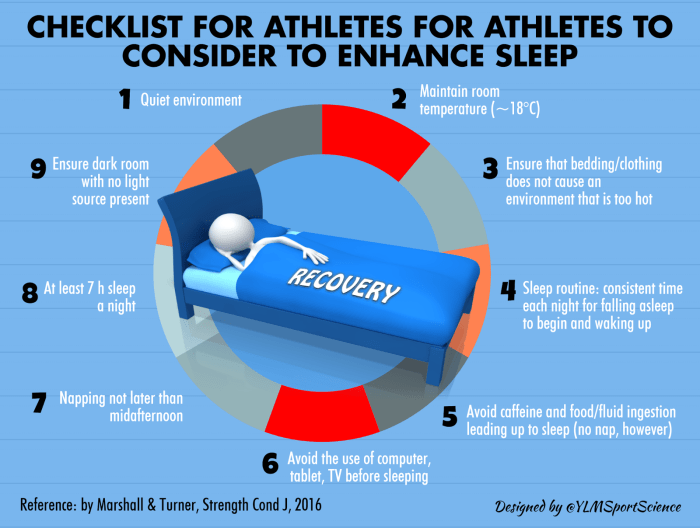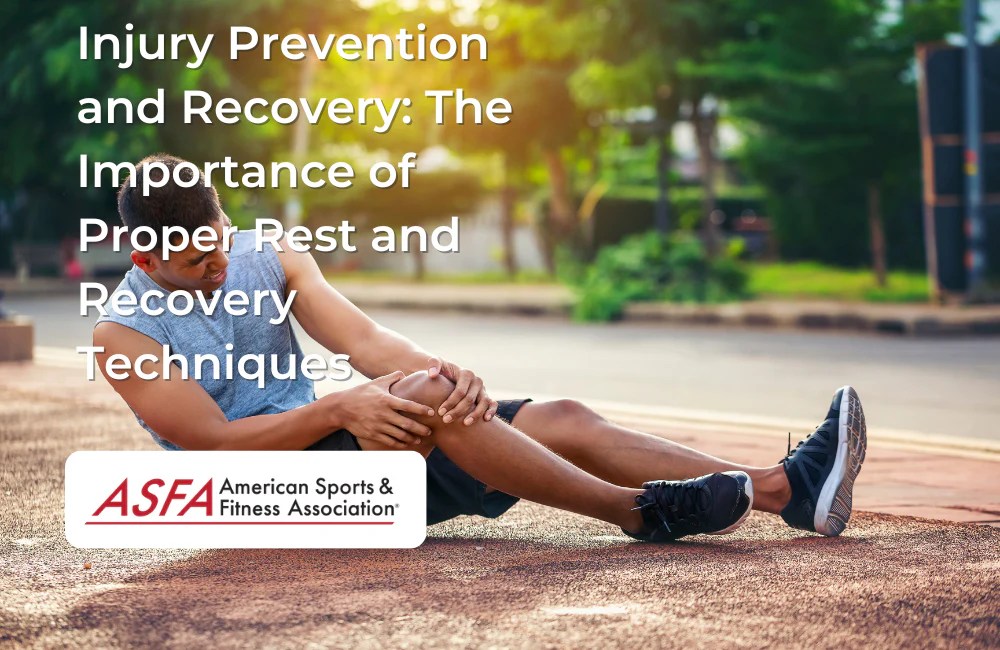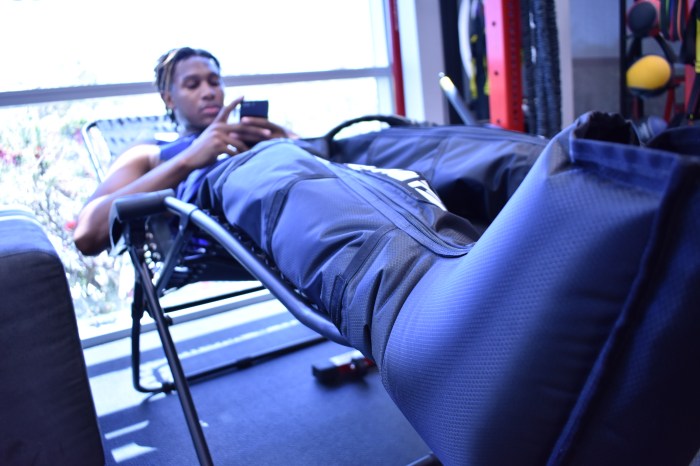Rest and Recovery Techniques: Your Guide to Optimal Performance

Rest and recovery techniques are not just for athletes; they are essential for everyone seeking to optimize their physical and mental well-being. Whether you’re a busy professional, a dedicated student, or an avid sports enthusiast, incorporating effective rest and recovery strategies into your daily routine can significantly enhance your performance, reduce stress, and improve your overall quality of life.
This guide explores the science behind rest and recovery, delving into the physiological and psychological benefits of prioritizing downtime. We’ll examine active and passive recovery methods, from light exercise and mindfulness practices to sleep optimization and proper nutrition. By understanding the key principles and implementing personalized strategies, you can unlock your body’s natural ability to repair, rejuvenate, and thrive.
The Importance of Rest and Recovery
Rest and recovery are not merely luxuries; they are essential components of a healthy and productive life. Adequate rest allows the body and mind to repair and rejuvenate, setting the stage for optimal performance and well-being.
The Physiological Benefits of Rest and Recovery
Rest and recovery are crucial for maintaining physical health and optimizing performance. During rest, the body engages in various restorative processes, including:
- Muscle Repair and Growth: Exercise causes microscopic tears in muscle fibers. Rest allows these tears to repair and rebuild, leading to muscle growth and increased strength.
- Hormonal Balance: Rest promotes the release of growth hormone, which is essential for muscle growth, tissue repair, and overall well-being. It also helps regulate cortisol levels, reducing stress and promoting recovery.
- Energy Restoration: Rest allows the body to replenish its energy stores, including glycogen, which is the primary fuel source for muscles.
- Immune System Enhancement: Adequate sleep strengthens the immune system, making the body better equipped to fight off infections and diseases.
The Psychological Benefits of Rest and Recovery
Rest and recovery are equally vital for mental well-being and cognitive function. During rest, the brain engages in essential processes, such as:
- Memory Consolidation: Sleep plays a crucial role in transferring information from short-term to long-term memory, improving learning and recall.
- Emotional Regulation: Rest helps regulate emotions, reducing stress, anxiety, and depression. It allows the brain to process and integrate experiences, promoting emotional stability.
- Cognitive Enhancement: Adequate rest improves focus, concentration, and decision-making abilities. It also enhances creativity and problem-solving skills.
Consequences of Chronic Sleep Deprivation and Insufficient Recovery
Chronic sleep deprivation and insufficient recovery can have significant and detrimental effects on both physical and mental health, leading to:
- Increased Risk of Chronic Diseases: Chronic sleep deprivation is linked to an increased risk of heart disease, stroke, diabetes, and obesity. It also weakens the immune system, making individuals more susceptible to infections.
- Impaired Cognitive Function: Sleep deprivation impairs attention, memory, and decision-making abilities. It can also lead to increased impulsivity and decreased reaction time.
- Mood Disorders: Chronic sleep deprivation is a significant risk factor for depression, anxiety, and other mood disorders. It can exacerbate existing mental health conditions.
- Increased Risk of Accidents: Sleep deprivation can significantly impair alertness and judgment, increasing the risk of accidents at work, on the road, and in other settings.
Impact of Rest and Recovery on Performance
Rest and recovery are essential for optimal performance in various aspects of life, including:
- Work Performance: Adequate rest improves focus, concentration, and problem-solving abilities, leading to increased productivity and creativity at work.
- Sports Performance: Rest and recovery allow athletes to repair muscle damage, replenish energy stores, and optimize their performance. Insufficient rest can lead to fatigue, injuries, and decreased performance.
- Relationships: Rest and recovery promote emotional well-being, which is essential for healthy relationships. Adequate rest helps individuals manage stress, improve communication, and maintain healthy relationships.
Active Recovery Techniques

Active recovery is a crucial aspect of any fitness routine, as it helps your body recover from strenuous workouts and prepare for the next challenge. Unlike passive recovery, which involves complete rest, active recovery techniques engage your body in light activities to promote blood flow, reduce muscle soreness, and enhance overall well-being.
Light Exercise
Light exercise plays a vital role in active recovery by promoting blood circulation and removing metabolic byproducts from your muscles. This gentle activity helps to reduce muscle soreness and stiffness while improving flexibility and range of motion.
- Walking: Walking is a low-impact exercise that can be easily incorporated into your recovery routine. It helps to increase blood flow and improve circulation, reducing muscle fatigue and promoting relaxation. Aim for a brisk walk for 20-30 minutes at a moderate pace.
- Cycling: Cycling is another great option for active recovery. It provides a cardiovascular workout without putting excessive strain on your joints. You can choose a leisurely pace or opt for a slightly more challenging ride, depending on your fitness level and recovery needs.
- Swimming: Swimming is a highly effective active recovery activity as it provides a full-body workout with minimal impact on your joints. The buoyancy of water reduces stress on your muscles, while the resistance of the water strengthens them. Swimming for 30-45 minutes at a moderate pace can be beneficial for recovery.
Stretching
Stretching is an essential component of active recovery, as it helps to improve flexibility, range of motion, and muscle recovery. By lengthening muscles, stretching reduces tightness and improves blood flow, promoting relaxation and reducing the risk of injury.
- Static Stretching: This type of stretching involves holding a stretch for a specific period, typically 15-30 seconds. Examples include holding a hamstring stretch, quad stretch, or calf stretch.
- Dynamic Stretching: Dynamic stretching involves controlled movements through a range of motion, such as arm circles, leg swings, or torso twists. It helps to prepare your body for exercise by increasing blood flow and flexibility.
Foam Rolling
Foam rolling is a self-massage technique that involves using a foam roller to apply pressure to specific muscle groups. It helps to release muscle tension, improve flexibility, and reduce muscle soreness.
- Benefits: Foam rolling can help to reduce muscle soreness and stiffness by breaking up knots and adhesions in the muscle tissue. It can also improve the range of motion, reduce inflammation, and enhance recovery time after strenuous exercise.
- Technique: When foam rolling, apply pressure to the targeted muscle group and slowly roll back and forth. Hold any tender spots for 30-60 seconds, allowing the pressure to release tension. You can use a foam roller on your back, legs, hips, and shoulders.
Massage
Massage therapy can be a highly effective active recovery technique, as it helps to reduce muscle soreness, improve circulation, and promote relaxation. A professional massage can help to loosen tight muscles, increase blood flow, and release endorphins, which have pain-relieving properties.
- Types of Massage: There are many different types of massage therapy, including Swedish massage, deep tissue massage, and sports massage. Each type has its unique benefits and techniques, and the best choice will depend on your individual needs and preferences.
- Benefits: Massage therapy can help to reduce muscle soreness and stiffness, improve flexibility and range of motion, reduce stress and anxiety, and promote sleep. It can also help to reduce inflammation and improve circulation.
Passive Recovery Techniques
Passive recovery techniques are essential for promoting rest and rejuvenation, allowing your body and mind to fully recover from the demands of physical activity and daily life. These techniques involve minimal physical exertion and focus on calming the body and mind, facilitating a state of relaxation and restoration.
Sleep
Sleep is a fundamental aspect of passive recovery, offering numerous benefits for physical and mental well-being. During sleep, your body repairs and rebuilds tissues strengthens your immune system, and consolidates memories. Adequate sleep is crucial for optimizing athletic performance, reducing injury risk, and enhancing cognitive function.
- Improved Muscle Recovery: Sleep allows your muscles to repair and rebuild after exercise, reducing muscle soreness and improving performance.
- Enhanced Immune Function: Sleep boosts your immune system’s ability to fight off infections and diseases.
- Improved Cognitive Function: Sleep is essential for memory consolidation, attention, and decision-making.
- Reduced Stress and Anxiety: Sleep deprivation can contribute to increased stress and anxiety levels, while adequate sleep helps regulate mood and emotional stability.
Relaxation
Relaxation techniques aim to reduce muscle tension, lower heart rate, and promote a state of calm and tranquility. These techniques can be particularly beneficial for individuals who experience high levels of stress or anxiety.
- Deep Breathing: Deep, slow breaths can help calm the nervous system, reduce muscle tension, and promote relaxation.
- Progressive Muscle Relaxation: This technique involves tensing and relaxing different muscle groups throughout the body, helping to release tension and promote relaxation.
- Meditation: Meditation involves focusing on the present moment, allowing thoughts to pass without judgment. It can help reduce stress, improve focus, and promote emotional well-being.
Mindfulness Practices
Mindfulness practices involve paying attention to the present moment without judgment. These techniques can help reduce stress, improve focus, and enhance emotional regulation.
- Mindful Walking: This practice involves paying attention to the sensations of walking, such as the feeling of your feet on the ground and the movement of your body.
- Mindful Eating: This practice involves paying attention to the taste, smell, and texture of food, savoring each bit,e and enjoying the experience.
- Body Scan Meditation: This technique involves bringing your attention to different parts of your body, and noticing any sensations without judgment.
Comparison of Passive Recovery Techniques
| Technique | Benefits | Drawbacks | Recommended Duration ||—|—|—|—|| Sleep | Improved muscle recovery, enhanced immune function, improved cognitive function, reduced stress and anxiety | Difficulty falling asleep, sleep disorders | 7-9 hours per night || Relaxation | Reduced muscle tension, lower heart rate, promotes relaxation | May require practice and commitment | 10-20 minutes per day || Mindfulness Practices | Reduced stress, improved focus, enhanced emotional regulation | May require practice and commitment | 10-20 minutes per day |
Nutrition for Rest and Recovery
Proper nutrition is crucial for muscle repair and energy replenishment after intense physical activity. Consuming a balanced diet rich in essential nutrients can significantly enhance your body’s recovery process, allowing you to bounce back faster and perform at your best.
Key Nutrients for Recovery
The right nutrients play a vital role in muscle repair and energy replenishment. Here are some key nutrients to prioritize:
- Protein: Protein is essential for muscle growth and repair. After exercise, your body needs protein to rebuild muscle tissue that has been broken down during training. Aim to consume 0.8 grams of protein per kilogram of body weight daily or 0.36 grams per pound.Good sources include lean meats, poultry, fish, eggs, dairy products, beans, lentils, and tofu.
- Carbohydrates: Carbohydrates are your body’s primary energy source. During exercise, your body depletes its glycogen stores, which are carbohydrates stored in your muscles and liver. Replenishing these stores is crucial for recovery and preventing muscle fatigue. Choose complex carbohydrates like whole grains, fruits, vegetables, and legumes.
- Electrolytes: Electrolytes, such as sodium, potassium, and magnesium, are lost through sweat during exercise. Replenishing these minerals is important for maintaining fluid balance, muscle function, and nerve impulses. Sports drinks or electrolyte-rich foods like bananas, coconut water, and leafy greens can help restore electrolyte levels.
Sample Meal Plan for Recovery
Here is a sample meal plan that incorporates nutrient-rich foods to optimize recovery:
Breakfast
- Oatmeal with berries and nuts: This provides complex carbohydrates for energy, protein for muscle repair, and antioxidants from berries.
- Scrambled eggs with whole-wheat toast: A good source of protein and complex carbohydrates.
Lunch
- Grilled chicken salad with quinoa: Lean protein, complex carbohydrates, and fiber for satiety.
- Tuna sandwich on whole-wheat bread: Protein, complex carbohydrates, and healthy fats.
Dinner
- Salmon with roasted vegetables: Omega-3 fatty acids for inflammation reduction, protein for muscle repair, and vitamins and minerals from vegetables.
- Lentil soup with whole-wheat bread: Protein, fiber, and complex carbohydrates.
Snacks
- Greek yogurt with fruit: Protein, calcium, and probiotics for gut health.
- Trail mix: A combination of nuts, seeds, and dried fruit for protein, healthy fats, and energy.
It’s important to note that individual needs may vary depending on factors like training intensity, duration, and individual dietary preferences. Consult with a registered dietitian or sports nutritionist for personalized guidance.
Environmental Factors for Optimal Recovery
Your environment plays a significant role in your ability to rest and recover effectively. Factors like light, temperature, and noise can significantly impact your sleep quality and overall recovery. Creating a conducive sleep environment can promote relaxation and restful sleep, leading to better recovery and overall well-being.
Light Exposure
Light exposure significantly influences your sleep-wake cycle. Exposure to bright light during the day helps regulate your circadian rhythm, promoting alertness and energy levels. Conversely, reducing light exposure in the evening signals your body to prepare for sleep.
- Minimize blue light exposure in the evening: Blue light emitted from electronic devices like smartphones, tablets, and computers can suppress melatonin production, a hormone that regulates sleep. Consider using blue light-filtering glasses or apps to reduce blue light exposure in the evening.
- Create a dark and quiet sleep environment: A dark room helps your body produce melatonin, promoting sleepiness. Consider using blackout curtains or an eye mask to block out light.
Temperature
The ideal temperature for sleep is between 60-67 degrees Fahrenheit (15.5-19.4 degrees Celsius). A slightly cooler temperature helps regulate your body temperature and promotes sleep.
- Adjust your room temperature: Use a thermostat to adjust your room temperature to a comfortable level. If your bedroom is too warm, consider using a fan or opening a window for ventilation.
- Wear breathable sleepwear: Choose loose-fitting, breathable sleepwear made from natural fabrics like cotton or silk. This will help regulate your body temperature and prevent overheating.
Noise
Noise can significantly disrupt sleep and hinder recovery. A quiet environment is crucial for restful sleep.
- Minimize noise sources: Identify and eliminate noise sources in your bedroom, such as traffic, neighbors, or household appliances. Consider using earplugs or a white noise machine to block out unwanted sounds.
- Create a calming atmosphere: Use soothing sounds like nature sounds or calming music to create a relaxing atmosphere in your bedroom.
Individualized Recovery Strategies
Everyone recovers differently, and there is no one-size-fits-all approach to rest and recovery. Individualized recovery strategies consider personal factors that influence recovery needs, ensuring optimal results for each individual.
Factors Influencing Individual Recovery Needs
Several factors influence individual recovery needs, requiring a personalized approach to rest and recovery. These factors include:
- Age: Younger individuals tend to recover faster due to their higher metabolic rate and faster tissue repair. Older individuals may experience slower recovery due to decreased muscle mass and hormonal changes.
- Activity Level: Individuals with higher activity levels require more time and resources for recovery. Athletes, for example, need more rest and nutrition to repair muscle damage and replenish energy stores.
- Health Conditions: Existing health conditions, such as injuries, chronic diseases, or autoimmune disorders, can significantly impact recovery time and strategies. Individuals with these conditions may require specific adjustments to their recovery plans.
- Training Intensity and Volume: Higher training intensity and volume lead to greater muscle damage and fatigue, requiring more time for recovery.
- Sleep Quality: Adequate sleep is crucial for muscle repair and hormonal regulation. Poor sleep quality can hinder recovery and increase the risk of injury.
- Stress Levels: Chronic stress can negatively impact recovery by elevating cortisol levels, which can suppress the immune system and hinder muscle repair.
- Nutrition: A balanced diet rich in protein, carbohydrates, and essential nutrients supports muscle repair and energy replenishment. Poor nutrition can delay recovery and increase the risk of fatigue and injury.
- Hydration: Adequate hydration is essential for maintaining body temperature, transporting nutrients, and removing waste products. Dehydration can hinder recovery and increase the risk of fatigue and muscle cramps.
Personalizing Recovery Strategies
Personalizing recovery strategies based on individual circumstances and goals is crucial for optimal results. Consider these steps:
- Assess Individual Needs: Conduct a thorough assessment of your current fitness level, training history, health conditions, and lifestyle factors. This will help you identify your unique recovery needs.
- Set Realistic Goals: Set realistic recovery goals that are achievable and aligned with your overall fitness objectives. Avoid pushing yourself too hard too soon, as this can lead to overtraining and injury.
- Experiment with Different Techniques: Try different active and passive recovery techniques to find what works best for you. Some individuals may respond better to foam rolling, while others may prefer stretching or massage.
- Listen to Your Body: Pay attention to your body’s signals and adjust your recovery strategies accordingly. If you are feeling fatigued or sore, take extra rest or reduce your training volume.
- Seek Professional Guidance: If you have any concerns about your recovery or are unsure about the best approach, consult a qualified healthcare professional or certified personal trainer.
Examples of Customized Recovery Plans
Here are examples of customized recovery plans for different individuals and their specific needs:
- Beginner Athlete: This individual may benefit from a recovery plan that emphasizes active recovery techniques, such as light walking or swimming, along with adequate sleep and a balanced diet.
- Experienced Athlete: This individual may require a more comprehensive recovery plan that includes a combination of active and passive recovery techniques, such as foam rolling, massage, and cold therapy.
- Individuals with Chronic Condition: This individual may need a customized recovery plan that addresses their specific health needs, such as modifying training intensity, incorporating specific exercises, or using assistive devices.
The Role of Hydration in Recovery

Staying hydrated is crucial for optimal recovery and performance. Water plays a vital role in numerous bodily functions, making it essential for athletes and individuals engaging in regular exercise.
Importance of Hydration for Muscle Function
Adequate hydration is crucial for muscle function. Water is a key component of muscle tissue, contributing to its structure and function. It facilitates nutrient delivery and waste removal, essential processes for muscle repair and growth. During exercise, muscles rely on water to regulate temperature and prevent overheating.
Impact of Dehydration on Recovery and Performance
Dehydration can negatively impact recovery and performance. When the body is dehydrated, it struggles to maintain optimal body temperature, leading to fatigue and reduced endurance. Dehydration also impairs muscle function, reducing power output and increasing the risk of injury.
Tips for Staying Hydrated
- Drink water throughout the day: Make it a habit to sip water regularly, even when not thirsty.
- Carry a water bottle: Keep a reusable water bottle handy and refill it frequently.
- Consume hydrating foods: Include fruits and vegetables with high water content in your diet, such as watermelon, cucumbers, and spinach.
- Monitor urine color: Pale yellow urine indicates adequate hydration, while dark yellow suggests dehydration.
- Drink water before, during, and after exercise: Replenish fluids lost through sweat by drinking water before, during, and after workouts.
Recognizing Signs of Overtraining

Overtraining is a common issue among athletes and fitness enthusiasts, resulting from excessive training without sufficient rest and recovery. It can lead to a decline in performance, increased risk of injuries, and even burnout. Recognizing the signs of overtraining is crucial for preventing these negative consequences and ensuring long-term training success.
Common Signs of Overtraining
Recognizing the early signs of overtraining is crucial for addressing the issue before it becomes more severe. Here are some of the most common indicators:
- Fatigue: Persistent and excessive fatigue, even after adequate sleep, is a hallmark of overtraining. This fatigue may extend beyond physical exertion, impacting mental clarity and overall energy levels.
- Decreased Performance: A noticeable decline in athletic performance, such as slower times, decreased strength, or reduced endurance, is a strong indicator of overtraining. The body is unable to recover sufficiently from previous training sessions, leading to a decline in overall performance.
- Mood Changes: Overtraining can significantly impact mood, leading to increased irritability, anxiety, depression, or even feelings of apathy. The body’s hormonal balance is disrupted, contributing to these mood swings.
- Increased Resting Heart Rate: A higher resting heart rate, even in the absence of physical activity, can indicate that the body is not fully recovering from previous training sessions. This elevated heart rate reflects the body’s increased effort to maintain basic functions.
- Muscle Soreness and Stiffness: Persistent muscle soreness and stiffness, even after a day or two of rest, can be a sign of overtraining. The body is unable to repair muscle tissue adequately, leading to ongoing discomfort.
- Increased Risk of Injury: Overtraining weakens the body’s immune system, making it more susceptible to injuries. The compromised immune system cannot adequately repair and rebuild tissues, leading to a higher risk of injury.
- Sleep Disturbances: Overtraining can disrupt sleep patterns, leading to difficulty falling asleep, frequent awakenings, or poor sleep quality. The body is unable to enter deep restorative sleep stages, essential for recovery and muscle repair.
- Loss of Appetite: Overtraining can suppress appetite, leading to decreased food intake and potential nutritional deficiencies. The body prioritizes energy expenditure for training over digestion and nutrient absorption.
- Increased Resting Blood Pressure: Elevated resting blood pressure, even in the absence of stress or physical activity, can be a sign of overtraining. The body’s hormonal balance is disrupted, contributing to increased blood pressure.
Managing Overtraining, Rest, and recovery techniques
Addressing overtraining is essential for preventing injuries and promoting long-term health. Here are some strategies for managing overtraining and ensuring adequate rest and recovery:
- Reduce Training Volume: The most effective way to address overtraining is to reduce training volume and intensity. This allows the body to recover and rebuild, preventing further decline in performance and increasing the risk of injury.
- Increase Rest and Recovery: Adequate rest and recovery are crucial for allowing the body to repair and rebuild after training. This includes getting enough sleep, incorporating rest days into the training schedule, and engaging in active recovery techniques.
- Focus on Nutrition: Proper nutrition is essential for providing the body with the nutrients it needs to recover and rebuild. Focus on consuming a balanced diet rich in protein, carbohydrates, and healthy fats to support muscle repair and energy replenishment.
- Hydration: Staying adequately hydrated is essential for optimal recovery. Dehydration can impair muscle function, increase fatigue, and delay recovery time.
- Stress Management: Chronic stress can contribute to overtraining. Implementing stress management techniques, such as meditation, yoga, or deep breathing exercises, can help reduce stress levels and promote recovery.
- Listen to Your Body: Pay attention to your body’s signals and take breaks when needed. Do not ignore fatigue, pain, or other signs of overtraining. Allowing the body to rest and recover is essential for long-term training success.
“Overtraining is a complex issue that can have a significant impact on an athlete’s performance, health, and well-being. Recognizing the signs and addressing the issue promptly can prevent serious consequences and ensure long-term success.”
Ultimate Conclusion: Rest And Recovery Techniques

As you embark on your journey to prioritize rest and recovery, remember that it’s not about achieving perfection but about making conscious choices that support your well-being. By embracing the principles articulated in this guide, you can cultivate a sustainable approach to rest and recovery that empowers you to reach your full potential and live a more fulfilling life.
Comments are closed.